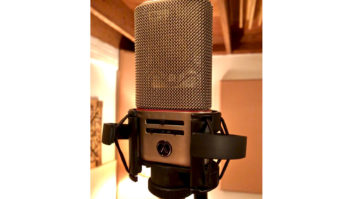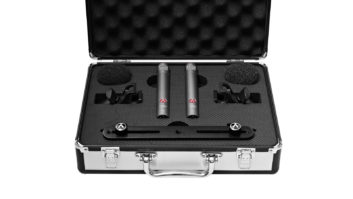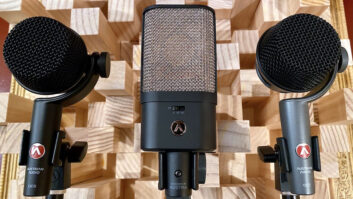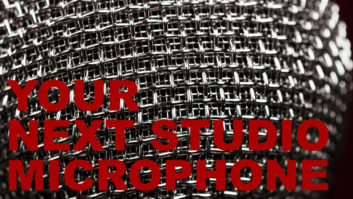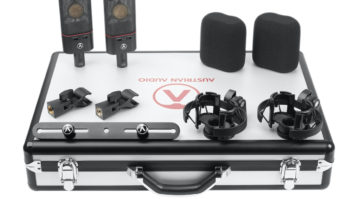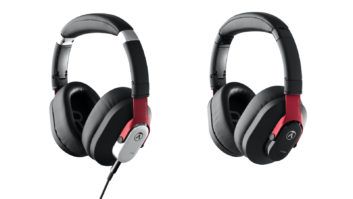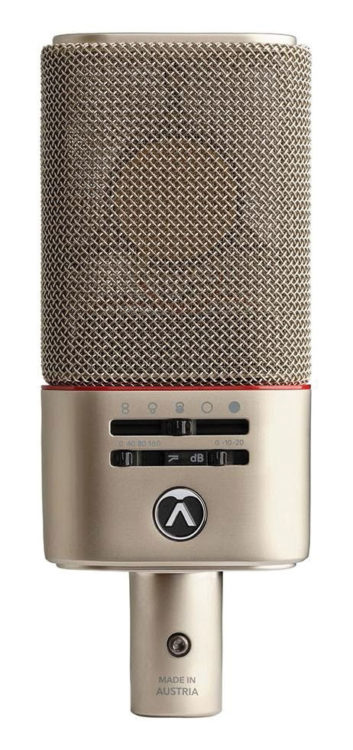
When AKG ceased production of microphones in its Vienna facility several years ago, many of the company’s employees were left in a lurch. As a result, a group of almost two dozen former AKG personnel—with more than 350 years of cumulative microphone expertise—banded together to form Austrian Audio. The goal of the new company is to push microphone technology into the future, while respecting their legacy of accomplishments.
One of those accomplishments was the CK12 capsule, heart of the Telefunken ELA M 251, AKG C12 and AKG C414. The engineers at Austrian Audio worked diligently to develop a new capsule that could be manufactured to consistent, tight tolerances while possessing the same sonic attributes as the best examples of the CK12. The result is the CKR12, a hand-made, dual-diaphragm ceramic capsule that uses the same backplate design as a “brass ring” CK12.
The CKR12 capsule is the centerpiece of the OC818, a large-diaphragm, multi-pattern condenser microphone. The OC818 has a distinct appearance with a silver, rounded, rectangular grille dominating about two-thirds of the mic’s profile. Beneath the grille is the CKR12, internally shock mounted to reduce mechanically transmitted noise. Three switches on the front of the microphone control polar pattern (omni, cardioid, supercardioid and figureeight), pad (0, -10 dB and -20 dB), and HPF (Off, 40 Hz, 80 Hz and 160 Hz). A fifth setting on the pattern switch ( • ) is called “Preset Mode” and hints at the mic’s capabilities. Found on the back of the microphone is a mini-XLR jack and a captive rubber plug to keep dirt from entering the jack (more on that in a minute). The OC818 is powered via +48 VDC phantom power (±4 V) and draws a maximum current of 4 mA.
OUT OF THE BOX
Austrian Audio sent Mix the OC818 Studio Set, which ships in an aluminum briefcase with a shock mount, hard mount, windscreen and an XLR-to-mini-XLR cable. The briefcase slips inside an outer printed cardboard sleeve and is secured with a red ribbon that’s reminiscent of an expensive gift box. Initially I scoffed at the included Quick Start guide (instructions for a microphone?) but the OC818 has some interesting super-powers that warrant a look at the paperwork.
The OC818’s mini-XLR port accepts one of two accessories, the first being the XLR-to-mini-XLR cable. Plugging in this cable and setting the pattern switch to cardioid allows the OC818 to be used as a dual-output microphone. The front side of the capsule is output via the “normal” XLR connector, while the rear side of the capsule is sent to the mini-XLR jack. When used as a dual-output mic, the front is recorded to channel 1 of a stereo track and the rear is recorded to channel 2 of the same track.
Austrian Audio’s PolarDesigner plug-in is inserted into the track, and can be used to adjust the polar pattern, post-recording. You could, for example, record a room mic on drums using the dual outputs, and dial in the polar pattern while mixing. Very clever. PolarDesigner is available free of charge and supports VST, AU and AAX formats. As you’d expect, the OC818 operates as a “normal” multi-pattern microphone when using only the main XLR output.
The OC818’s mini-XLR jack also accepts the OCR8 Bluetooth Dongle. When the OCR8 is plugged in and the pattern switch is set to Preset Mode, pattern control is accomplished remotely via an iOS or Android device running Austrian Audio’s PolarPilot app (free of charge). PolarPilot also enables remote control over the HPF and pad, features a clipping log meter, and supports storage and recall of favorite settings. The OC818 retains the most recent setting in Preset Mode, even after the OCR8 is disconnected, or if the mic has been turned off and back on again. If you switch out of Preset Mode, PolarPilot allows you to monitor status of the microphone settings.
Austrian Audio stresses that the audio path of the OC818 is strictly analog; only the capsule bias voltage that is being adjusted remotely. The dongle derives its power from 48V phantom, and the manufacturer cautions that the OC818 does not take very well to phantom supplies outside of the specified requirements.
INTO THE STUDIO
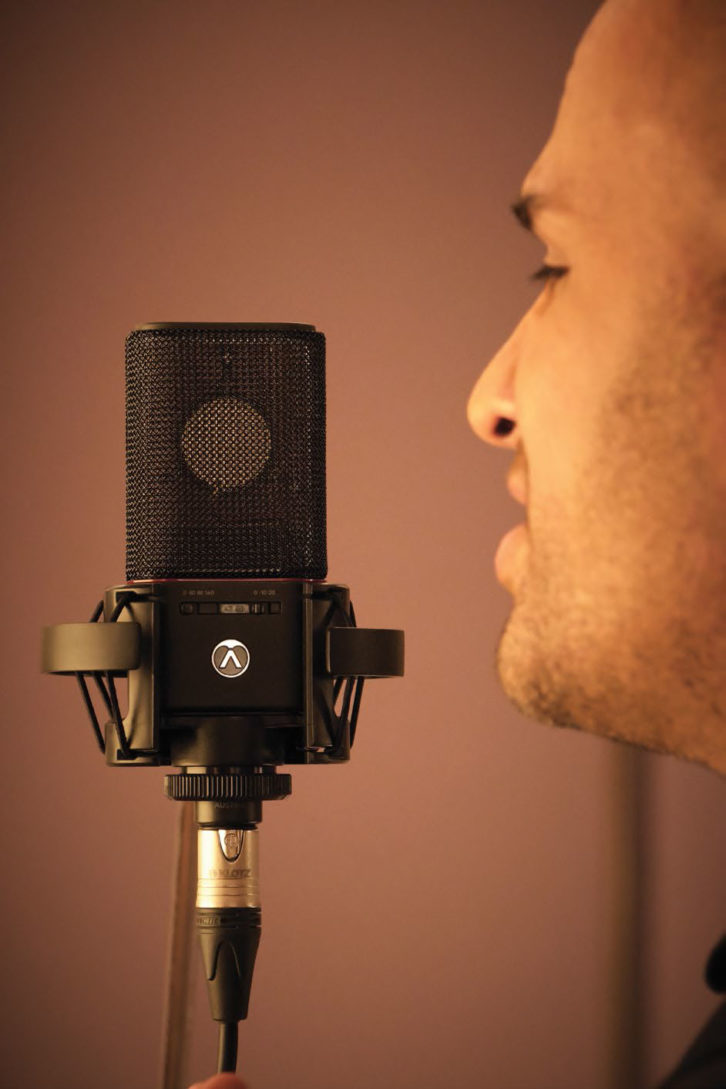
Fitting the OC818 into its shock mount was a refreshing change, given the parade of crummy offshore mounts that seem to be everywhere. A large knurled nut closes a plastic clamp that grips the stem of the mic securely in the cradle without scratching, and although the mount is constructed from plastic, it doesn’t look or feel cheap. The shock mount and hard mount employ threaded brass inserts, so you needn’t worry about plastic threads wearing out or stripping. When the pivot is tightened, it stays put. If you’re using the dongle or the mini-XLR, you’ll need to connect them before securing the mic in its cradle.
First up was using the OC818 as a room mic for drums. Given the application, I connected the mini-XLR cable and recorded the front and back sides of the capsule to a stereo track. I inserted PolarDesigner on the track, which allowed me to manipulate the pickup pattern after recording. It was pretty cool to be able to instantly compare the differences between the various patterns, and PolarDesigner provides a few intriguing options, such as proximity effect on/off and reverse cardioid, whereby you are effectively turning the back of the mic toward the source. The OC818 captured a realistic representation of what drums sound like in this particular room—balanced and smooth, with a tight solid kick drum and a good representation of the room’s ambient signature.
PolarDesigner offers multi-band pattern control across as many as five frequency bands, permitting you, for example, to combine the bottom end of the OC818’s omni pattern with the midrange and HF response of its cardioid pattern. While I found PolarDesigner useful for adjusting the OC818’s pattern in post, I also felt that dividing it into multiple bands could become a bit of a rabbit hole.
Next was an acoustic guitar session where I was able to A/B the OC818 to a C414 EB (brass capsule). The OC818 produced a clear top end, with excellent articulation of pick on strings. Bottom end was full without being overbearing, and I was a bit surprised at how much alike these mics sounded in this application.
In a different studio setting I recorded a Taylor acoustic guitar using the OC818 and a Great River MP2-NV preamp. The mic was set to cardioid, HPF to 40 Hz, and with the mic placed near the 12th fret, the low end was overwhelming. Changing the HPF to 80 Hz tamed the low end a bit, but setting it to 160 Hz improved overall clarity and helped the instrument sit in the mix nicely. The OC818 produced an excellent balance of the body resonance and attack.
The OC818’s slide switches have a solid feel and click firmly into place. Changing patterns produces a dull thump in the audio path, and it’s worth noting that the OC818 requires a few seconds to stabilize when switching between patterns.
I had the opportunity to try the OC818 on several different male voices, all with good results. One particular recording sounded very natural, yet at the same time flattering. There was no hype in the top or bottom and the entire spectrum was represented evenly—definitely a good choice for this particular singer. Proximity effect becomes evident within about eight inches distance and blooms nicely around 6 inches away from the grille. Closer than that and it becomes a bit much, but setting the HPF to 80 Hz cleans it up nicely for situations where the singer wants to work really close to the grille. As expected, proximity effect is most pronounced in figure-eight. Off-axis response is forgiving out to abut ±30 degrees, after which point the top end begins to drop off [see below for more recording session info].
If you’re looking for a versatile multi-pattern microphone that has a nice feature set and will be useful in a wide variety of applications , you definitely need to listen to the OC818.
OC-Stereo
Austrian Audio also sent Mix an OC18, a cardioid-only version of the OC818. The manufacturer boasts that tolerance between CKR12 capsules is within 1 dB from sample to sample, and that an OC818 and an OC18 can be used as a stereo pair—so I put it to the test recording stereo drum overheads and acoustic piano.
Drums
I switched the OC818 to cardioid, set the pad and HPF switches to the same settings for both mics, and placed the pair in X-Y stereo over the kit. Lo and behold, the two mics did indeed create a stereo pair! They were so closely matched that I’d defy anyone to tell the difference between the two. The kit sounded natural but not boring, with an extended response at both extremes and no hype. Cymbals were smooth (never spitty) and toms were round with plenty of presence and impact. Imaging was solid bot not particularly wide, typical for X-Y.
Piano
Used to record a Steinway Model A Salon Grand (circa 1910, rebuilt), the mics were placed in X-Y stereo, about a foot above the hammers and two thirds of the way toward the high register. After a bit of experimentation, the HPFs were set to 80 Hz to reduce pedal noise and tighten the low end a bit without destroying the instrument’s weight.
Initially, the piano’s music rack was in place, but the instrument sounded like it had a cold. Removing the rack opened up the clarity and reduced boxiness. The results were excellent: smooth, clear and consistent from top to bottom without overemphasis of any register of the keyboard. The delicate top end of the instrument was captured beautifully.
The fact that an OC818 can be paired with another OC818 or an OC18 is a definite strength for the microphone.
PRODUCT SUMMARY
COMPANY: Austrian Audio
PRODUCT: OC818 Large Diaphragm Condenser Microphone
WEBSITE: https://austrian.audio
PRICE: $999; OCR8 Bluetooth Dongle: $149
PROS: Smooth, balanced response; useful in a variety of applications; remote pattern control; dual-output enables adjustment of polar pattern post-recording; matches well with other samples
CONS: might not be the best choice on didgeridoo
